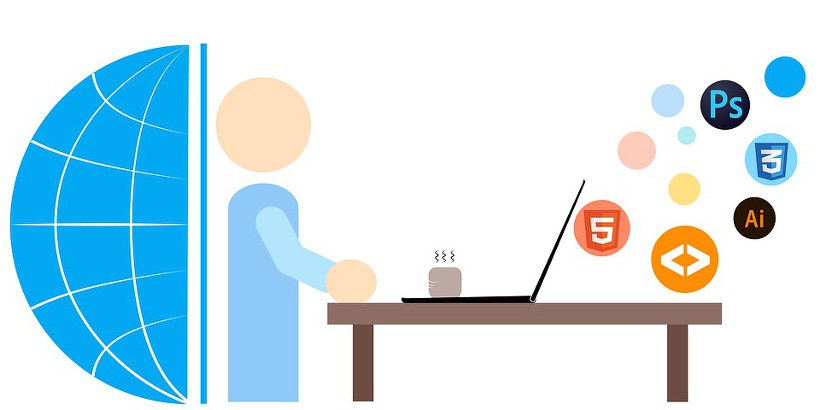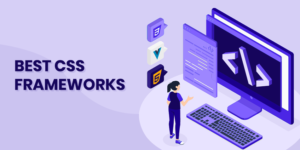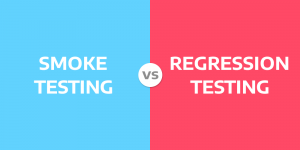
Every profession requires a set of tools for quality and optimum delivery. Web developers are not excluded from this. They need the right laptop or desktop and software to create quality web development deliverables on time.
Web development involves creating high-ranking and intuitive websites for brand positioning. However, it’s a broad subject with three different functions that may require different computer specs and softwares:
- Front-end web development involves creating the feel and look of a website across all devices. It includes the appearance of the site’s images, icons, color, etc. You will require programming languages like HTML, CSS, Javascript, and JQuery.
- Back-end web development involves creating and maintaining the technology that connects the server, application, and database to empower the website. It ensures web user requests and transactions are processed properly. You will require Java, PHP, Python, MySQL, Golang, etc.
- Full-stack development involves handling both the back and front-end functions of web development. It is a highly rewarding broad skill set and experience that comes in handy in troubleshooting or speeding up the site.
Why do you require a Laptop for Web development
In the dynamic world of web development, a laptop stands as the quintessential tool, embodying the fusion of innovation and practicality. Beyond its physical form, a laptop represents the gateway to boundless creativity and productivity for developers worldwide.
At the core of a laptop’s significance lies its unparalleled portability. Far from being tethered to a fixed workspace, developers wield the freedom to craft digital marvels from any location imaginable. Whether nestled in a bustling urban cafe, under the serene canopy of nature, or amidst the collaborative energy of a shared workspace, the laptop is a reliable companion, adapting seamlessly to the ever-changing rhythms of the modern world.
Yet, the true essence of a laptop’s prowess lies in its ability to transform into a personalized sanctuary for developers. With many customization options, developers curate bespoke environments tailored to their unique workflows and preferences. From selecting the ideal operating system to fine-tuning development frameworks and tools, the laptop extends the developer’s creative vision, enabling them to transcend limitations and realize their boldest ideas.
In the intricate dance of web development, real-time testing and debugging are akin to refining a delicate masterpiece. Here, the laptop for web development emerges as a trusted ally, allowing developers to scrutinize their creations across diverse browsers, devices, and screen sizes. With this capability, developers precisely navigate the labyrinth of coding intricacies, ensuring seamless user experiences that captivate and inspire.
Moreover, the laptop is a nexus for collaboration, bridging distances, and fostering connections among dispersed teams. Equipped with various collaboration tools and communication platforms, developers converge in virtual spaces, weaving together the threads of creativity and expertise to craft digital wonders that transcend boundaries.
The laptop emerges as a beacon of professionalism and innovation in client engagement and presentation. With its power to showcase prototypes, demonstrate functionalities, and gather real-time feedback, the laptop becomes the conduit through which ideas take flight, forging enduring partnerships built on trust and shared vision.
Having said that, it is important to select a laptop that can handle your specific workflow and blend with your lifestyle. Let’s discuss some of the factors to consider when choosing your web development laptop.
How to Choose a Laptop for Web Development
1. Choose the Right Specifications
A. Lifestyle
If you’ll always be on the go, then a light laptop with longer battery life is preferable. A laptop offering 5-10 hours of battery life on a single charge is perfect. It makes such laptops an exceptional convenience for users on the go.
However, if you’ll be using your laptop over the desk most of the time, it’s better to replace it with a more robust desktop alternative. Besides, you may need to work with several resources and run a couple of programs like Affinity Designer, Source Tree, etc.
You may need a large touch screen monitor or more to work efficiently and simultaneously across various windows and programs. Touch screen monitors for PC give an immersive experience across your workstation. Like your tablet or phone, you can swipe, pinch to zoom or tap your monitors without the need for a mouse or keyboard.
With such a big-screen experience, you can add other devices like gaming to further increase functionality. We recommend a 4K touch screen monitor for superior resolution. But they should be compatible with what you have. For port compatibility, you can choose a USB touch screen monitor if your laptop supports it.
However, if you are an Apple devices enthusiast, then it’s preferable to go for a touchscreen monitor for Mac.
So, go for what suits your lifestyle and is compatible with your devices.
B. Web Development Tools
Another aspect to consider while choosing your laptop specs is the tools you will use. If you will be using Sublime Text, Firebug, HttpFox, and other web dev tools, an Intel Core i3 or i5. Alternatively, you can go with AMD’s A8 or A10 APU.
Using heavy web tools like Adobe Photoshop, GIMP, etc., requires a laptop with a faster CPU. It will offer a quicker rendering of effects and computations. Hence, your tools of the trade should guide the laptop specs you go for.

C. Performance
As mentioned earlier, the tools you are planning to use will dictate the level of performance you need.
For an advanced level of web development that uses Java, JavaScript, Python, etc., you will need a certain bare minimum to have smooth operations. For minimum requirements should include:
- AMD Ryzen processor or Intel Core i5 (8th generation)
- 8 GB RAM (DDR4)
- 256 SSD
- Intel HD 610 (GT1)
- Screen resolution of 1366 X 768 pixels.
But, we recommend these specs for robust performance:
- Intel Core i5/i7 (10th generation) or AMD Ryzen 3 processors and above.
- 16 GB RAM or more.
- 512 GB SSD and above.
- AMD Radeon or Nvidia GeForce GTX graphics card
- Screen resolution of 1920 X 1080 pixels.
D. Warranty and Service
The warranty period and service level are also vital for your consideration. You don’t want to spend excessive time without your laptop because of poor service. Get a laptop with a good warranty and great, reliable service.
2. Set your Budget

Image Source – Pexels
Although we should have started with your budget, knowing your minimum requirement specs beforehand is better.
The good news is that web development does not need as much hardware as graphic development. You will only require a fast CPU and good RAM size. Ultra-performing CPUs and graphic cards are a bonus but not necessary.
However, a quality laptop you can keep for a couple of years will cost you more. But it shouldn’t put you off because there are several options for almost all price ranges of $200-$1000 and above.
3. Storage Capacity
When selecting a laptop for web development, prioritizing storage capacity is crucial. Opt for a device with ample storage to accommodate project files, databases, and software installations without compromising performance. A minimum of 256GB SSD ensures swift data access, enhancing workflow efficiency.
4. Graphic Capability
When considering a laptop for web development, don’t overlook graphic capability. Opt for a laptop with dedicated graphics or a powerful integrated GPU to handle design tasks efficiently. Look for models with at least 4GB of VRAM for smooth rendering of complex graphics and animations.
Graphic capability is crucial for running design software like Adobe Creative Suite or Sketch, ensuring seamless workflow and accurate visual representation. High-resolution displays with vibrant color accuracy further enhance the development experience. Prioritize laptops with robust graphic capabilities to unleash your creativity and bring your web designs to life with
5. Display Quality
When delving into web development, the quality of the laptop’s display is paramount. Opt for a laptop with a high-resolution screen, preferably Full HD (1920×1080) or higher, for crisp text and vibrant colors. A larger screen size, around 15 inches or more, provides ample workspace for coding, designing, and previewing websites simultaneously.
Additionally, consider display features like IPS technology for wide viewing angles and color accuracy, which is crucial for assessing design elements accurately. Investing in a laptop with excellent display quality for web development ensures visual clarity, reduces eye strain during long coding sessions, and enhances overall productivity and creativity in web development endeavors.
6. Probability And Battery Life
When selecting a laptop for web development, consider both performance and battery life. Look for a device with a reliable processor, such as an Intel Core i5 or AMD Ryzen 5, for smooth multitasking and efficient coding. Aim for at least 8GB of RAM to handle demanding development tasks effectively.
Additionally, prioritize laptops with long battery life to sustain productivity throughout the day, especially when working remotely or during client meetings. Look for models with power-efficient processors and battery optimization features to maximize uptime. Balancing performance and battery life ensures uninterrupted workflow and enhances productivity in web development endeavors.
7. Build Quality
When seeking a laptop for web development, prioritize sturdy build quality. Opt for devices crafted from durable materials like aluminum or magnesium alloy, ensuring longevity amidst daily use. A robust build protects internal components from accidental bumps or knocks, safeguarding your investment.
Look for laptops with reinforced hinges and spill-resistant keyboards, crucial for withstanding the rigors of frequent typing and travel. Additionally, consider devices that undergo stringent quality testing for reliability and durability. Investing in a well-built laptop guarantees uninterrupted workflow, minimizes downtime, and ensures continued productivity in web development projects.
8. Connectivity
When selecting a laptop for web development, prioritize connectivity options. Look for devices with diverse ports, including USB-A, USB-C, HDMI, and Ethernet, to accommodate various peripherals and external displays. Built-in Wi-Fi 6 or Ethernet connectivity ensures fast and stable internet access, essential for downloading updates and collaborating online.
Additionally, consider laptops with Bluetooth capabilities for seamless connectivity with wireless peripherals like mice and keyboards. Prioritizing robust connectivity features enhances versatility and productivity, enabling smooth collaboration and efficient workflow management in web development projects.
9. Input Device and Output Device
When buying a laptop for web development, consider input devices like keyboards and touchpads for comfort and responsiveness. Prioritize ergonomic designs to enhance coding and design tasks. Opt for laptops with high-resolution displays for output for crisp text and accurate color representation.
External monitor connectivity facilitates multitasking and website previewing. Reliable audio output is essential for testing web app audio features. Evaluating these factors ensures an optimal user experience, enhancing efficiency and creativity in web development.
10. Choose an OS
Each laptop’s operating system (OS) has its advantages and disadvantages. Therefore, you should know which OS you wish to use for your web development.
Microsoft’s Windows OS enjoys incredible global popularity. It also has a large web development community and flexible price points for any budget.
Linux is also a common OS amongst web developers, but it is slightly complex. However, it supports great customization to match your needs.
Chrome OS is also common to web development OS. Chrome OS only supports web development tools run through the browser.
Mac OS is another alternative for deep-pocket users. It comes complete with access to virtualization tools, git, etc. Despite its powerful performance, it is only available on Apple devices that are relatively more expensive than other manufacturers.
11. Research and Compare
To make an informed decision for a laptop for web development, conduct thorough research and compare laptop options. Explore specifications such as processor speed, RAM capacity, storage type, and graphics capability to ensure compatibility with development tools and software.
Consider portability, battery life, and build quality to align with your work environment and usage preferences. Evaluate customer reviews and expert opinions to gauge reliability and performance. Additionally, compare pricing and warranty options to maximize value and peace of mind. By diligently researching and comparing laptops, you’ll find the perfect fit for your web development needs, optimizing productivity and creativity.
Also Read: What are the Requirements for Choosing a Laptop for Game Development?
Take Away
Front-end, back-end, and full-stack web development have different skills, tools, and computer hardware requirements. They tax your computer hardware differently, and additional strain may result from running other functions.
You’ll use common programming languages like HTML, JavaScript, and CSS for the front-end. The back-end may need additional computation hardware given the higher performance tools and programs like Python, Java, MySQL, etc.
If you’re a full-stack web developer, you’ll need to take care of both the server-side and user end of the website.
For optimum performance, you can work with a faster CPU and with at least 8 GB of RAM. Intel 8th generation Core i5 or equivalent can work just fine. However, for max performance across the spectrum of web development, we recommend higher specs in processor, RAM and graphics card.
Additional considerations include the laptop’s battery life and relevant port systems to support multiple screens. You can add touch screen monitors to run and track all programs simultaneously.
Also read: 6 Factors That Have a Major Impact on the Success of Your eCommerce Store






